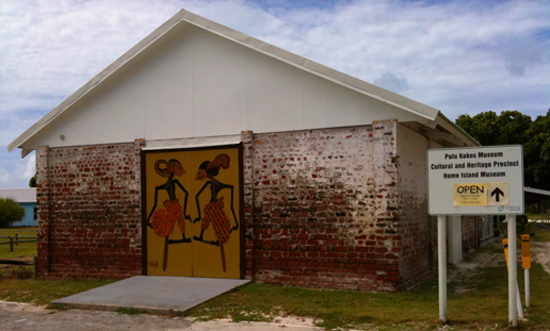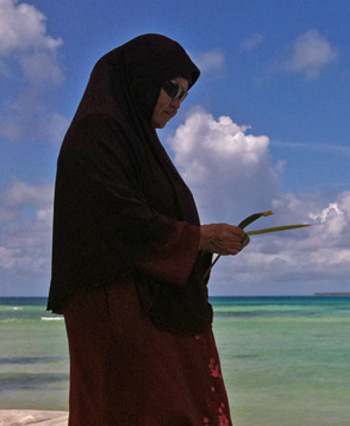Despite isolation and multiple migrations the Cocos Malays maintain a resilient culture
Nicholas Herriman and Monika Winarnita
Making ketupat while waiting for the local transport at the West Island boat ferry terminalNicholas Herriman |
From South Africa to the Middle East, and Sri Lanka to Australia, Indonesians have long travelled around the Indian Ocean, establishing communities that hold on to the customs and languages of their homeland. The experience of the Cocos Malays provides a fascinating, if often overlooked, story of one such Indonesian migration in the Indian Ocean.
Situated about 1000km south of Java and Sumatra, the Cocos (Keeling) Islands are part of Australia’s Indian Ocean territories. The northern atoll, Keeling Island, is uninhabited, while its southern counterpart, the Cocos Islands atoll, has only two inhabited islands: West and Home. A total population of around 600 people is split between the two. West Island is home to over 100 people mostly from the Australian mainland. The 470 or so residents of Home Island, by contrast, form a Malay community or ‘kampong’. This community has a longstanding connection with Indonesia.
The White Rajas
The ancestors of the Home Island community were slaves, convicts and indentured labourers, mostly brought from the Indonesian archipelago in 1826. At the time, there was a power vacuum in much of Southeast Asia. Indigenous rulers held their capitals but their authority had diminished away from these centres. European powers controlled isolated trading fortresses, which would later expand to become vast colonial empires. In between, however, a few merchant adventurers fancied that there was plenty of places in Southeast Asia open for conquest – territories where they could establish themselves as White Rajas.
Alexander Hare was almost successful in this endeavour. Importing slaves from Java and elsewhere in Indonesia, he created a large territory for himself in southern Borneo in 1812 at the invitation of the Sultan of Banjarmasin and in the full knowledge of Sir Stamford Raffles. The Dutch, however, were suspicious of Hare, and he and his retinue of Indonesian slaves were moved on (these slaves, despite having Dutch certificates of emancipation, appear to have signed themselves and their children over to Hare as ‘property’ and thus depended on him). The Cape of Good Hope colony was more amenable to his entourage, but they headed off again, arriving on the as yet uninhabited Cocos Islands in 1826.
So Hare had people and now the land, but his dreams of empire were again forestalled, this time by another merchant adventurer, John Clunies-Ross, who had visited the islands the previous year. Relations between the two men quickly became hostile and Hare ultimately left the Cocos Islands and its population in 1831, disappearing several years later somewhere in the interior of South Sumatra. The Clunies-Ross dynasty ruled over the islands until 1984, when the Australian government assumed formal control of the islands.
The Cocos Malays
Who were the people John Clunies-Ross counted as his subjects? The Cocos Malays were not ‘Malay’ in the sense of the ethnic group that lives around the Straits of Malacca, but were rather in the broad colonial sense, that is, natives of Southeast Asia. In 1836, Clunies-Ross wrote that the 120 men, women and older children of the island included ‘natives of the Malay Peninsula, Sumatra, Borneo, Celebes, Java, Bali, Sumbawa, Timor, New Guinea, and the Cape of Good Hope, and Indian and Chinese descendants, the majority being of the Malayan or Brown race of people.’ What’s clear is that the people of the Cocos Islands spoke Malay and were identified as being nominally Muslim.
This diverse population was put to work exporting coconut products made from the many coconut palms on the islands. Some argue that the Clunies-Ross family abused their status (upheld by a Malay-Indonesian notion of divine, mediatory kingship), while members of the dynasty described their rule as a benevolent family or clan-like relationship. When Charles Darwin recorded his visit to the islands in 1836 in the 3 April entry of his Journal of Researches he described a population living in conditions of slavery.
Aside from an occasional Javanese seaman who settled on the island, the next wave of immigration took place under John Clunies-Ross’ great grandson, John Sidney Clunies-Ross, who inherited the rulership from his father, George Clunies-Ross, in 1910. John Sidney arranged with the Dutch authorities to bring in convicts and chain-gang criminals from Java. These Orang Banten (Bantamese), as they were known, were initially housed in a separate village, separated from the original group who were now called the Orang Cape (Cape of Good Hope people), after their sojourn so many years before. The Bantenese spoke a range of Javanese dialects and brought with them shadow puppets and other Javanese cultural artefacts. Some of them stayed on after their terms had expired, marrying Orang Cape women and settling in the Cocos.
By this time, a mixed culture seemed to have developed. Years of intermarriage, the unification of the two villages and the incorporation of Javanese words into the Cocos Malay dialect marked the integration of the two populations. A European influence could also be discerned. Over the years, the Clunies-Ross heritage could be heard in Scottish reels and in the names of some Cocos Islanders (such as ‘Anggas’ and ‘Boyd’). European boat designs were used and English words incorporated into the local dialect. Unions were made between European staff and local women. Indeed, John Clunies-Ross’ son, John George, twice married Javanese women and his grandson married a Cocos Malay. The offspring of this latter marriage, John Sidney Clunies-Ross, reportedly had ‘very distinct traces of Eastern blood’ and spoke ‘English rather poorly’.
From Home to Australia
The Cocos Island community went into crisis when poor management and a fall in coconut prices rendered the 1930s population of approximately 1800 people unsustainable. The Clunies-Ross family provided passage for Cocos Malays to resettle on Christmas Island, in Singapore and in Sabah. Christmas Island, situated 900km east-northeast of Cocos Island, was the site of a large phosphate mining operation. Singapore, still a British colony, was a thriving international port. In Sabah, also a British colony, Cocos Malay were put to work restoring plantations near Tawau (near the Indonesian border), where they eventually established a village named Balong Kokos after the Cocos Islands.
During the 1930s and 1940s, more than three quarters of the Cocos Malay population emigrated, leaving less than 400 on Home Island. A further, smaller-scale wave of emigration occurred in the 1970s, with Cocos Malays (including some who had already moved to Christmas Island) settling predominantly in five Western Australian locations: Katanning, Geraldton, Hedland, Canning Vale, and Bunbury. Some went to Katanning and Geraldton to work in abattoirs exporting frozen halal meat. Others made their way to Hedland to work in the burgeoning Pilbara iron ore industry.
 |
The Cocos Islands MuseumNicholas Herriman |
Since the Cocos Islands became part of Australia in 1984, emigrants to the ‘north’ (Singapore and Sabah) and their descendants have begun to return to Home Island and links with Western Australian communities have strengthened. The predominant migratory pattern has been southwards: Cocos Malays from Singapore and Sabah migrated to Home Island, and those on Home Island migrated to Western Australia, especially to Canning Vale, an eastern suburb of Perth and Bunbury, a small town in the south-west where a Cocos Malay community has developed.
Indonesian connections today
But there are still connections between Home Island and Indonesia. Those living there can understand visitors who speak Indonesian, although Cocos Malay has developed into a distinct dialect with strong Javanese elements. Java sometimes figures in discussions of culture and identity, with Banten mentioned particularly often. The sense of tradition is apparent, for instance, in the melenggok dance (in which two males dance as a pair) and in silat martial arts performances, both of which feature in marriage celebrations. Some Indonesians continue to marry Cocos islanders and migrate to Home Island.
More obvious contemporary links with Indonesia are maintained through television. The available satellite television connections only broadcast Australian and Indonesian channels. The Australian channels can’t begin to compete with the popularity of Indonesian programs, especially the sinetron soap operas, which are broadcast in three hour stretches across the Island’s five Indonesian channels. The grandparents’ generation prefer the Indonesian channels due to their lack of fluency in English, but their children and grandchildren are just as involved in these dramas from far across the water.
Nicholas Herriman (n.herriman@latrobe.edu.au) is a lecturer in Anthropology at La Trobe University. Monika Winarnita (m.winarnita@latrobe.edu.au) is a PhD candidate at ANU and researcher at La Trobe University’s Centre for Dialogue.












